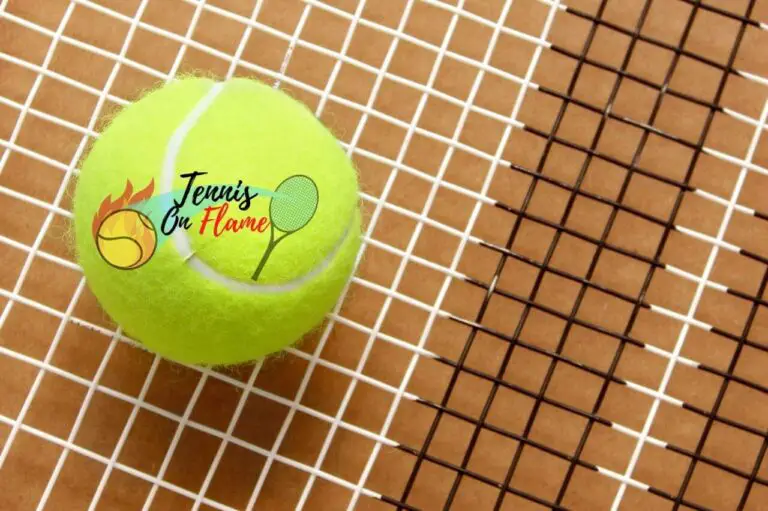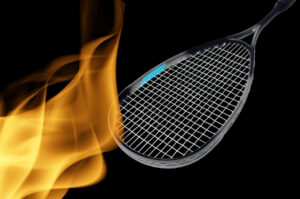There is a lot of debate surrounding how tight tennis racket strings should be.
Some people believe that they should be very tight, while others think that they should be looser. So, what is the right answer?
In this blog post, we will explore the different schools of thought on this topic and help you decide what is right for you!
What does string tension do?
The tension of the strings is measured in lbs (pounds) or kg and it is determined by how tight they are attached to the racket’s frame.
String tension has a big impact on the way your racket plays. It affects the power, control, and spin of your shots.
A lower tension gives greater power, and tighter stringing allows greater control.
How tight should your tennis racket strings be?
The average tension is between 40 to 65lbs.
It’s typical to String elastic materials, such as nylon or natural gut, at a tension of 50 to 60 lbs.
When using a stiffer string such as polyester, lower the tension to prevent arm injuries.

What is the best tension for tennis racquet strings?
The optimum string tension for most players is usually between 48 and 54 pounds.
What are the factors that can influence the best tension for your strings?
The answer to this question is not as simple as it may seem.
There are a variety of factors that can influence the best tension for your strings. These include:
-The type of string you are using.
-Your playing style.
-Your level of experience.
-Your personal preference.
Let’s take a closer look at each of these factors:
-Type of string
The type of string you are using can have a big impact on the tension you should use. For example, the Natural gut tennis string is the best string available because it can maintain tension better than any other type of string.
Additionally, at high tensions, it stays soft– making it much more arm beneficent than synthetic strings.
-Playing style
Your playing style can also be a factor in determining the best string tension for you. If you are a power player who likes to hit the ball hard, you will probably benefit from lower string tension. This will give you more power on your shots.
If you are a control player who likes to place the ball, you will probably benefit from a higher (tighter) string tension. This will give you more control and spin on your shots.
-Level of experience
Your level of experience can also play a role in determining the best string tension for you. If you’re just starting, you might want to have more control, so start with a tighter tension.
As you get better, you can experiment with a looser tension for more power.
-Personal preference
In the end, the best string tension for you is going to be a matter of personal preference. Some players prefer a lower string tension for more power, while others prefer a higher(tighter) string tension for more control.
Ultimately, it is up to you to experiment with different string tensions and find the one that works best for your game.
What happened if your tennis strings are too tight?
If your tennis racket’s strings are too tight, you will have greater control over your serve, and the ball will have less rebound.
This will make your shots slower and less powerful, therefore you’ll have to put more power behind each swing for a fast shot.
What happened if your tennis strings are too loose?
Strings that are not too tight on a tennis racket provide more give or elasticity, making hitting, and returning shots with less force easier, and with more accurate and power
What are better, tight or loose strings?
A useful thing to remember in tennis is that the tighter you string your racket, the greater control you have over your serve. On the other hand, less tension generates more power.
Unless you’re a pro player, the majority of stringers recommend stringing your rackets as low as you can without sacrificing ball control.
So, there you have it! Some things to consider when deciding how tight to string your racket.
Ultimately, it’s up to you to decide what feels best for your game. Experiment with different tensions and see what works best for you. Good luck!
Should mains or crosses be tighter?
Generally, The main strings on your tennis racket should be tighter than the cross strings.
According to research, the majority of the players at Wimbledon follow the rule that main strings should be tighter than the cross strings, therefore they are keeping their main strings tighter strung by 2 to 4 pounds than their cross strings.
In contrast, the majority of American players use the same string tension for both mains and cross strings.
What tension does Roger use?
Roger Federer’s string tension is lower on the crosses at 25.5kg (56.1 lbs) while the mains are around 27kgs (59.4 lbs).
How frequently should you restring your racket?
On average, you should restring your racket as many times per year as you play per week. For example, if you play tennis three times a week, then you should restring your racket three times per year.
If you don’t play your instrument often, the strings will still stretch and lose their resiliency over time.
Ultimately, it is up to you to decide how often to restring your racket based on your playing habits. Experiment and see what works best for you.
In conclusion:
The best string tension for you is ultimately a matter of Playing style, level of experience, and personal preference.
Some players prefer a lower string tension for more power, while others prefer a higher (tighter) string tension for more control.
As you get better, you can experiment with different tensions and find the one that works best for your game.
I hope you enjoyed this comprehensive guide.
Stay tuned for more interesting guides regarding tennis racket
Do you have any questions or comments about How tight should tennis racket strings be? Let me know in the comments below, and I will be happy to answer you!
I’m inviting you to check out my other blog posts for more informative guides.
Thanks for reading, and have a nice day! 🙂








